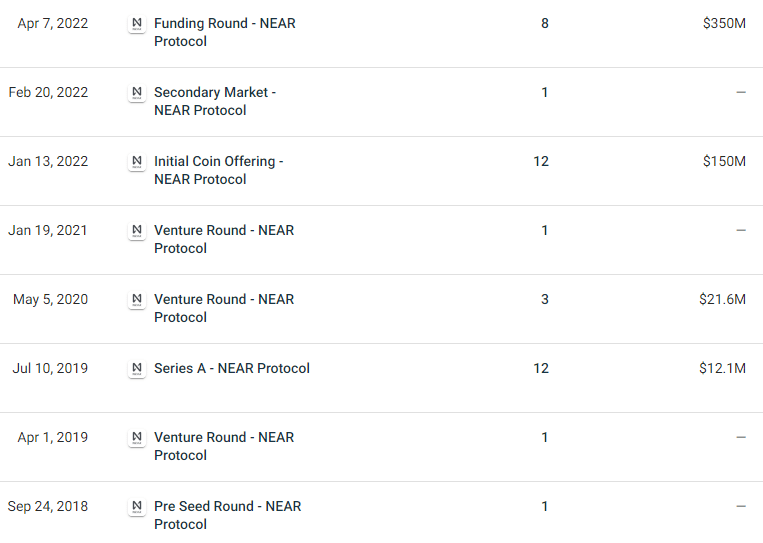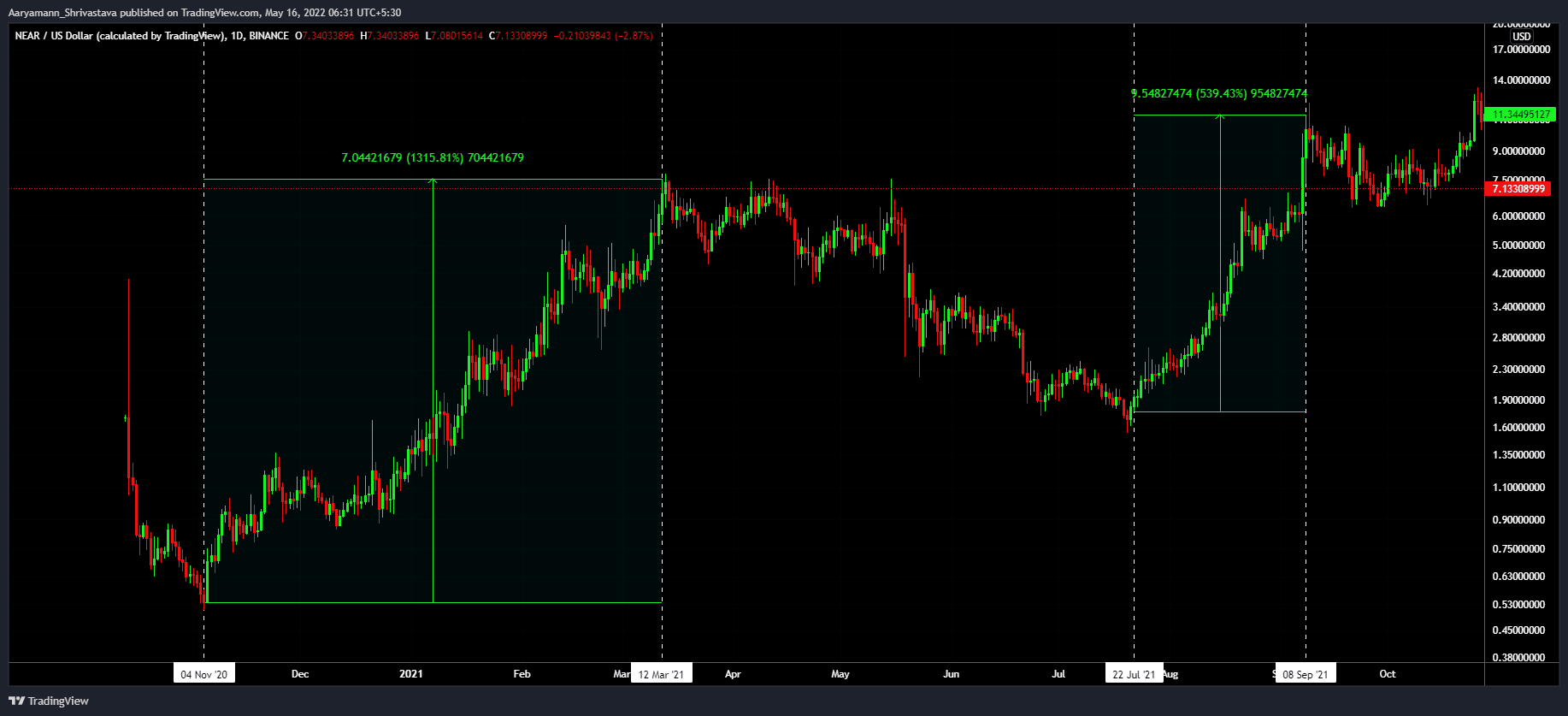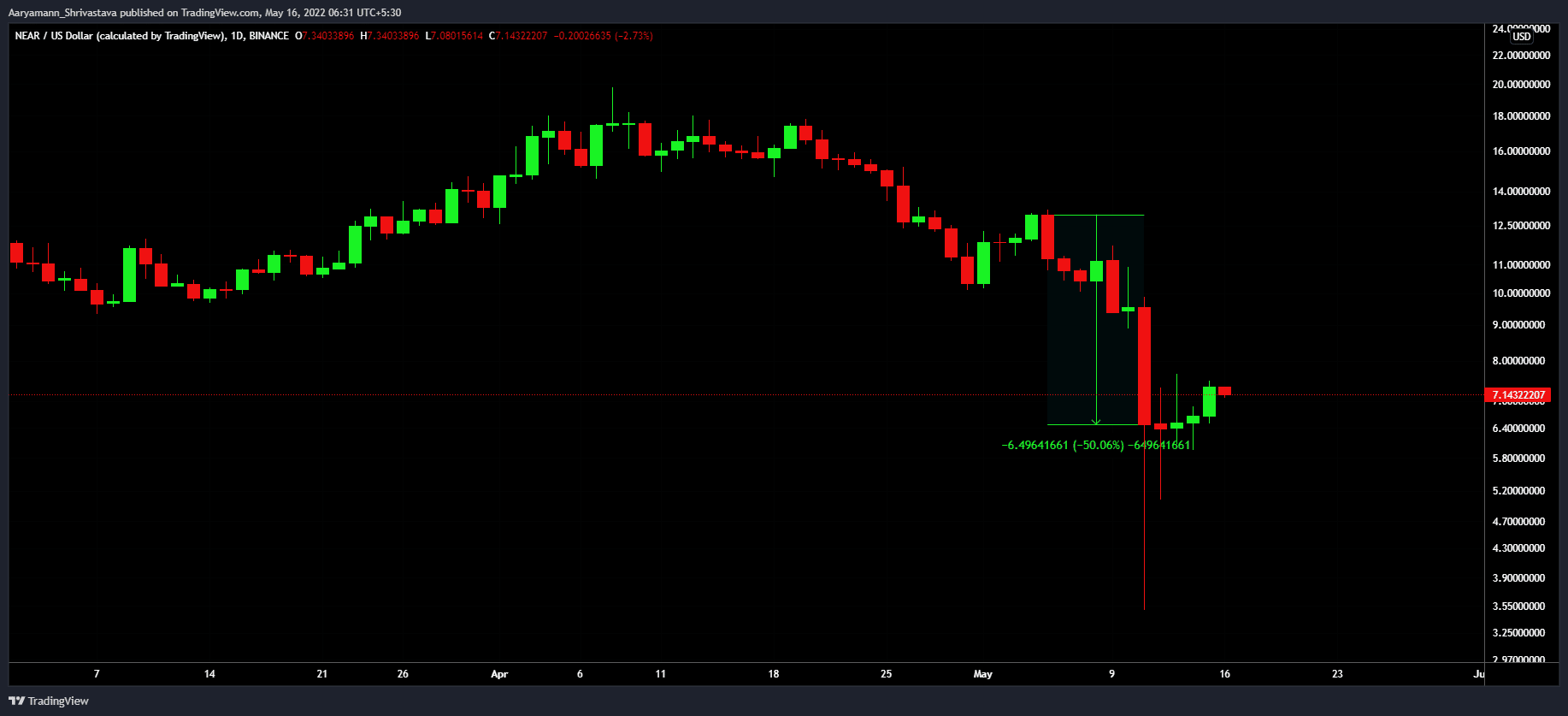NEAR is a smart contract supporting, Layer-1 blockchain created to tackle cryptocurrency’s scalability issues, which have grown to be one of the most significant problems for popular blockchains like Ethereum.
Based on the proof of stake consensus method, NEAR employs about 100 validators to protect the blockchain from a 51% attack that has been a concern for proof of work-based blockchains. Growing at a time when investors and developers alike are looking for a sustainable, scalable, and reliable blockchain, NEAR offers plenty of potential to become a severe competition to many similar blockchains in the crypto space.
In the following NEAR Protocol guide, we’ll go over the various proprietary technologies NEAR utilizes, including Nightshade, the Rainbow Bridge, and the Aurora layer-2.
How Does NEAR Protocol Work?
Proof of Stake (PoS) emerged as a replacement for the highly energy-consuming proof of work (PoW) consensus method, and it also prevents the blockchain from a 51% attack situation where miners take control of the consensus and pose a threat to the security of the chain.
NEAR deployed PoS on the chain, which is considered a significantly more sustainable method since it consumes remarkably lesser energy than PoW.
Secondly, one of the most significant features that NEAR provides is Nightshade. Nightshade is the most essential aspect of NEAR, being a sharding technology.
Sharding is a way of reducing the workload on the mainnet by running transactions and verification across multiple different validator nodes instead of backlogging all the verifications on the mainnet.
An excellent example of the latter situation is Ethereum, which, although planning on bringing Sharding with ETH 2.0, faces a lot of backlash from the community since it processes all the transactions on the mainnet.
This has resulted in long finality times as well as high gas fees, which at times have cost investors up to $50.
NEAR is also known for its Rainbow Bridge which solves another problem that Ethereum is looking to eliminate, the lack of cross-chain interoperability.
Connecting the Ethereum blockchain with the NEAR blockchain, the Rainbow Bridge enables the transfer of cryptocurrency assets as well as other stablecoins like USDT, USDC, UST, etc., ERC-20 tokens, Wrapped tokens (ex. WBTC, WETH, etc.) as well as NFTs (BAYC, CryptoPunks, etc.).
The way the bridge works is that instead of directly sending assets across chains, it locks the desired amount of assets by removing them from circulation from the sender’s chain and creating similar tokens on the receiving chains to balance the overall supply of the assets.
Being decentralized, the supply locked on the bridge is not held by any single entity making it less susceptible to rug pulls.
Third and another outstanding feature of the chain is Aurora, a Layer-2 solution on the NEAR blockchain, which has been created as a medium of extending the developers’ reach by allowing them to expand their DeFi applications on Ethereum-compatible platforms.
Being an EVM (Ethereum Virtual Machine), Aurora is supported by all the tools present in the Ethereum ecosystem. This enables developers to stretch the reach of their protocols without having to rewrite them for different chains.
On the DeFi front, NEAR is observing rapid growth thanks to the abovementioned features it supports.
Within the span of 3 months, the total value locked (TVL) on the chain had risen by 525% from $93 million to $517 million, before trickling down to $465 million on May 16 after losing $52 million during the crash of May 9.
With only six active protocols on the blockchain – Ref Finance, Burrow, Meta Pool, LiNEAR Protocol, Jumbo Exchange, and Oin Finance, NEAR hosts a range of Dapps from Decentralized Exchanges, Lending, Liquid Staking, and more.
The History of NEAR Protocol
Born as a machine learning project, NEAR took its time to become a blockchain development platform. Created by Illia Polosukhin and Alexander Skidanov in 2017, NEAR was a means of exploring program synthesis.
However, as the development team began experimenting with programmable smart contracts and crypto payments, they inched NEAR to what it is today. By August 2018, the founders and a team of engineers began building the NEAR Protocol.
Built with the purpose of being interoperable and scalable, Illia and Alex made sure the chain utilized the PoS consensus method.
Thus the chain was officially launched in April 2020 and became absolutely decentralized, i.e., controlled by the community by September 2020.
Being a chain developed from scratch (not being a hard fork), NEAR made it easier to achieve its goals than it would be to do the same on a chain with a code copied from some other chain.
But the chain isn’t entirely unique in its approach as other Layer 1 blockchains such as Ethereum and Polkadot also embody the goals of NEAR in some or different ways, with the former bringing PoS to life and the latter making sidechains popular in the crypto space.
However, NEAR, staying true to its intentions has made sure to become a preferred chain for Decentralized Finance by bringing grants into play for developers.
In line with the same, NEAR announced an $800 million funding initiative to support the growth of its ecosystem back in October 2021.
Apart from this, Proximity Labs also announced a $350 million grant DAO for the NEAR DeFi ecosystem. The research and development firm will be supporting the teams, organizations as well as individuals that are building DeFi protocols on the NEAR blockchain.
Through these grants and funding, as of May 16, more than 800 projects have been funded, and over $45 million have been awarded for development which includes the likes of NEAR Lands, Mintbase, ARterra, and more.
However, the support NEAR Protocol itself has received is also exceptional. In its lifetime of more than four years, NEAR has been subjected to 8 different rounds of funding in which the blockchain has cumulatively risen $533.7 million.
The two biggest funding rounds took place in 2022 alone, with the first occurring on January 13, 2022, when led by Three Arrows Capital NEAR raised $150 million with the help of 11 other investors.
The second funding round took place on April 7, during which the L1 blockchain raised $350 million from investors, including FTX Ventures and Hashed, led by Tiger Global Management.
Such support is evidence that NEAR is on the right path in its journey to tackle significant issues and provide solutions to its investors in the crypto space.
The Present Status of NEAR
While NEAR’s past has set itself up for a promising future on a technical front, its tokenomics also play a significant role in the blockchain’s growth.
NEAR Protocol’s native token NEAR received significant attention in 2022, entering the list of top 20 cryptocurrencies by market cap.
With a total supply of 1 billion NEAR, the blockchain has a fixed number of tokens to be minted in its lifetime, much like Bitcoin and unlike Ethereum.
As of May 16, 2022, a total of 688.6 million NEAR, or about 69% of the entire supply, was already in circulation, with each individual NEAR token valued at $7.27 at the time of writing.
Some of the highest growth LUNA ever noted was during November 2020 to March 2021 rally when in a span of 5 months, NEAR skyrocketed by 1,315.81%, with a similar rise noted in July 2021 when the altcoin shot up by 539% in 2 months and was trading at $9.7 by September 2021.
However, the last all-time high marked by NEAR was in January 2022, when the token hit $20.69 and attempted to establish a new one in April but to no avail.
Following this attempt, NEAR plummeted to a low of $3.5 within a week when the TerraUSD (UST) depegging caused the market to crash on May 9.
NEAR lost 50% of its value, but in the previous 24 hours, it managed to recover by 10% and is trading at $7.14 at the time of this report.
While apart from demand and DeFi use cases, there is no specific trigger for NEAR’s rallies, these two reasons are enough to keep up the consistent rise as that is what NEAR truly intends to be.
Available on every major cryptocurrency exchange such as Coinbase, Binance, FTX, Crypto.com, Gemini, OKX, and more.
Final Thoughts
NEAR Protocol paints a cryptocurrency future where smart contracts can be embedded for any need, at least at a more cost-efficient rate than that of Ethereum.
We will continue to update our guide as NEAR progresses– but for now, we’re particularly interested in how the protocol will expand its varied applications during a bear market.










